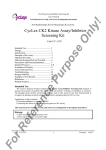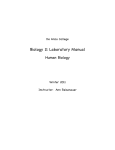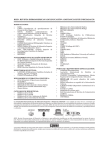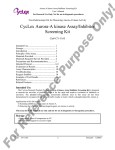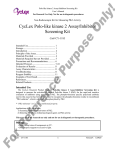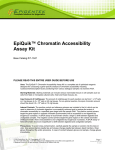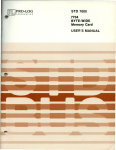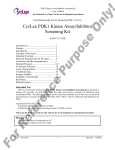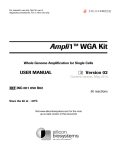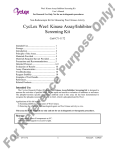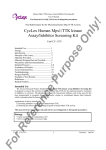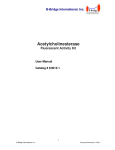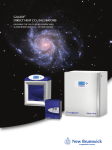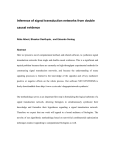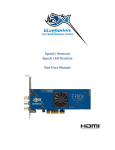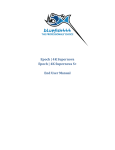Download For Reference Purpose Only!
Transcript
On Non-Radioisotopic Kit for Measuring Aurora A, B and C kinase activity ly ! Aurora Family Kinase Assay/Inhibitor Screening Kit User’s Manual For Research Use Only, Not for use in diagnostic procedures Cat# CY-1174 en ce Pu rp Intended Use................................................ 1 Storage......................................................... 1 Introduction.................................................. 2 Principle of the Assay.................................. 3 Materials Provided....................................... 4 Materials Required but not Provided........... 4 Precautions and Recommendations............. 5 Detailed Protocol......................................... 6-8 Evaluation of Results................................... 9 Assay Characteristics................................... 9 Troubleshooting........................................... 9 Reagent Stability.......................................... 9 Example of Test Results............................. 10-12 References................................................... 13 os e CycLex Aurora Family Kinase Assay/Inhibitor Screening Kit Intended Use The CycLex Research Product CycLex Aurora Family Kinase Assay/Inhibitor Screening Kit is designed to measure the activities of purified Aurora family kinase, Aurora A, B and C kinase for the rapid and sensitive evaluation of inhibitors or activators. The phospho-serine specific monoclonal antibody used in this assay kit has been demonstrated to recognize the phospho-serine residue in “Aurora-substrate-1”, which is phosphorylated by Aurora A, B and C kinase in vitro. er Applications of this kit include: 1) Screening inhibitors or activators of Aurora A, B and C kinase. 2) Detecting the effects of pharmacological agents on Aurora A, B and C kinase activity. ef This assay kit is for research use only and not for use in diagnostic or therapeutic procedures. Storage rR • Upon receipt store all components at 4°C. • Don’t expose reagents to excessive light. Fo Cat#: CY-1174 1 Version#: 120420 On Introduction ly ! Aurora Family Kinase Assay/Inhibitor Screening Kit User’s Manual For Research Use Only, Not for use in diagnostic procedures Pu rp os e Aurora kinases representing a novel family of serine/threonine kinases have been identified as key regulators of the mitotic cell division process. Aurora kinases are evolutionarily conserved enzymes that regulate different aspects of cell division. Only a single Aurora kinase is present in Saccharomyces cerevisiae (Ipl1) (1) and Schizosaccharomyces pombe (Ark1p) (2). In contrast, three distinct Aurora family members, termed Aurora A, B, and C, have been described in metazoan organisms (3, 4). A-type Aurora kinases localize to both centrosomes and spindle microtubules (5) and have been implicated in spindle assembly (6). The B-type Aurora kinases are present at centromeres in prophase and metaphase, before they relocalize to the central spindle and the midbody in anaphase and telophase (5, 7). The C-type Aurora kinases have so far been identified only in mammals (8). They are expressed primarily in testis and some tumor cell lines, where they have been localized to spindle poles. All three members of the mammalian kinase family have a catalytic domain that is highly conserved with a short C-terminal domain and an N-terminal domain of varying sizes. Significant interest in the subject was generated since all three Aurora kinases family members were reported to be overexpressed in many human cancers, and elevated expression has been correlated with chromosomal instability and clinically aggressive disease in some instances. Ectopic overexpression of one member of the family, Aurora-A, was shown to induce oncogenic transformation in cells (9). Unlike most other putative oncogenes identified, so far, members of this kinase family are expressed and active at the highest level during G2-M phase of the cell cycle. Measurement of Aurora kinases activity rR ef er en ce The protocol generally regarded as most sensitive for the quantitative measurement of Aurora A, B and C activity involves incubation of the Aurora A, B and C kinase sample with substrate, either a natural or synthetic polypeptide (such as Histone H3 N-terminal peptide) in the presence of Mg2+ and 32 P-labeled ATP. The reaction is terminated by "spotting" a sample onto a phosphocellulose P81 filter paper disc, followed by washing extensively to remove unincorporated radiolabel and the incorporated radioactivity on P81 filter is counted. While sensitive, this method is labor-intensive, generates hazardous radioactive waste, and depends on a radioisotope of short half-life. It is particularly unsuitable when kinase assays are only performed on an infrequent basis. The CycLex Research Product CycLex Aurora Family Kinase Assay/Inhibitor Screening Kit uses a peroxidase-coupled anti-phospho“Aurora-substrate-1” monoclonal antibody as a reporter molecule in a 96-well ELISA format. This assay provides a non-isotopic, sensitive and specific method to detect Aurora A, B and C activities. Fo Cat#: CY-1174 2 Version#: 120420 On Principle of the Assay ly ! Aurora Family Kinase Assay/Inhibitor Screening Kit User’s Manual For Research Use Only, Not for use in diagnostic procedures Pu rp os e The CycLex Research Product CycLex Aurora Family Kinase assay/Inhibitor Screening Kit is a single-site, semi-quantitative immunoassay for Aurora A, B and C kinase activity. Plates are pre-coated with a recombinant “Aurora-substrate-1” which contains a serine residue that is phosphorylated by Aurora A, B and C kinase. The detector antibody specifically detects only the phosphorylated form of “Aurora-substrate-1”. The CycLex Research Product CycLex Aurora Family Kinase Assay/Inhibitor Screening Kit can be used to study the kinetics of a purified Aurora A, B and C kinase as well as to screening these kinases inhibitor. To perform the test, the sample is diluted in Kinase Buffer, pipetted into the wells and allowed to phosphorylate the bound substrate in the presence of Mg2+ and ATP. The amount of phosphorylated substrate is measured by binding it with a horseradish peroxidase conjugate of AK-C17, an anti-phospho-“Aurora-substrate-1” specific antibody, which then catalyzes the conversion of the chromogenic substrate tetra-methylbenzidine (TMB) from a colorless solution to a blue solution (or yellow after the addition of stopping reagent). The color is quantified by spectrophotometry and reflects the relative amount of Aurora A, B and C kinase activity in the sample. For kinetic analysis, the sample containing Aurora A, B and C kinase is added to the wells in a similar fashion and at varying times the reaction is stopped by the addition of a chelator, sodium ethylenediaminetetraacetate (EDTA) and the amount of phosphorylated substrate determined as before. Summary of Procedure Add 100 µL of sample to the wells Incubate for 30 min at 30°C en ce Wash the wells Add 100 µL of HRP conjugated anti-phosphorylated form specific antibody Incubate for 30 min at room temp. Wash the wells er Add 100 µL of Substrate Reagent Add 100 µL of Stop Solution rR ef Measure absorbance at 450 nm Fo Cat#: CY-1174 3 Version#: 120420 On Materials Provided ly ! Aurora Family Kinase Assay/Inhibitor Screening Kit User’s Manual For Research Use Only, Not for use in diagnostic procedures All samples and standards should be assayed in duplicate. The following components are supplied and are sufficient for the one 96-well microtiter plate kit. os e Microplate: One microplate supplied ready to use, with 96 wells (12 strips of 8-wells) in a foil, zip-lock bag with a desiccant pack. Wells are coated with recombinant “Aurora-substrate-1” as substrate of Aurora A, B and C kinase. 10X Wash Buffer: One bottle containing 100 mL of 10X buffer containing 2 %Tween®-20 Kinase Buffer: One bottle containing 20 mL of 1X buffer; used for Kinase Reaction Buffer and sample dilution. rp 20X ATP: Lyophilized ATP Na2 salt. HRP conjugated Detection Antibody: One vial containing 12 mL of HRP (horseradish peroxidase) conjugated anti-phospho-Aurora-substrate-1 (AK-C17) antibody. Ready to use. Pu Substrate Reagent: One bottle containing 20 mL of the chromogenic substrate, tetra-methylbenzidine (TMB). Ready to use. Stop Solution: One bottle containing 20 mL of 1 N H2SO4. Ready to use. en ce Materials Required but not Provided rR ef er • Aurora A, B and C kinase positive control: Available from CycLex (Cat # CY-E1165, CY-E1174-1, and CY-E1174-2, respectively): One vial contains 8 units. Positive controls should be added to the first well at 40 m units/well. • 10X Staurosporine (10 µM): Staurosporine is available from Sigma, Cat#. S-4400. 1 mM stock solution (DMSO) diluted 1:100 in Kinase Buffer. • Pipettors: 2-20 µL, 20-200 µL and 200-1000 µL precision pipettors with disposable tips. • Precision repeating pipettor • Wash bottle or multichannel dispenser for plate washing. • Microcentrifuge and tubes for sample preparation. • Vortex mixer • Plate reader capable of measuring absorbance in 96-well plates at dual wavelengths of 450 nm/540 nm. Dual wavelengths of 450/550 or 450/595 nm can also be used. The plate can also be read at a single wavelength of 450 nm, which will give a somewhat higher reading. • 500 or 1000 mL graduated cylinder • Reagent reservoirs • Deionized water of the highest quality • Disposable paper towels Fo Cat#: CY-1174 4 Version#: 120420 ly ! Precautions and Recommendations On Aurora Family Kinase Assay/Inhibitor Screening Kit User’s Manual For Research Use Only, Not for use in diagnostic procedures • Store the ATP at -20°C in aliquots. Store all other components at 4°C. Do not expose reagents to excessive light. Avoid freeze/thaw cycles. • Allow all the components to come to room temperature before use. os e • All microplate strips that are not immediately required should be returned to the zip-lock pouch, which must be carefully resealed to avoid moisture absorption. • Do not use kit components beyond the indicated kit expiration date. • Use only the microtiter wells provided with the kit. rp • Rinse all detergent residue from glassware. • Use deionized water of the highest quality. Pu • Do not mix reagents from different kits. • The buffers and reagents used in this kit contain Kathon-CG as preservatives. Care should be taken to avoid direct contact with these reagents. • Do not mouth pipet or ingest any of the reagents. en ce • Do not smoke, eat, or drink when performing the assay or in areas where samples or reagents are handled. • Dispose of tetra-methylbenzidine (TMB) containing solutions in compliance with local regulations. • Avoid contact with Substrate Solution which contains hydrogen peroxide. • Avoid contact with Stop Solution which contains Sulfuric Acid. er • In case of contact with the Stop Solution and the Substrate Solution, wash skin thoroughly with water and seek medical attention, when necessary. • Biological samples may be contaminated with infectious agents. Do not ingest, expose to open wounds or breathe aerosols. Wear protective gloves and dispose of biological samples properly. rR ef • CAUTION: Sulfuric Acid is a strong acid. Wear disposable gloves and eye protection when handling Stop Solution. Fo Cat#: CY-1174 5 Version#: 120420 On Detailed Protocol ly ! Aurora Family Kinase Assay/Inhibitor Screening Kit User’s Manual For Research Use Only, Not for use in diagnostic procedures os e The CycLex Research Product CycLex Aurora Family Kinase assay/Inhibitor Screening Kit is provided with removable strips of wells so the assay can be carried out on separate occasions using only the number of strips required for the particular determination. Since experimental conditions may vary, an aliquot of the Aurora A or B or C kinase positive control (Cat # CY-E1165, CY-E1174-1, and CY-E1174-2, respectively), available separately from CycLex, should be included in each assay as a positive control. Disposable pipette tips and reagent troughs should be used for all liquid transfers to avoid cross-contamination of reagents or samples. Preparation of Working Solution rp 1. Prepare a working solution of Wash Buffer by adding 100 mL of the 10X Wash Buffer (provided) to 900 mL of ddH2O. Mix well. Store at 4°C for two weeks or -20°C for long-term storage. 2. Prepare 20X ATP Solution by adding 0.8 mL of ddH2O to the vial of 20X ATP (provided, lyophilized). Mix gently until dissolved. The Final concentration of the 20X ATP Solution should be 2.5 mM. Store the solution in small aliquots (e.g. 100 µL) at -20°C. Kinase Buffer (provided) 20X ATP (provided) 96 assays 10 assays 1 assay 9.5 mL 0.5 mL 950 µL 50 µL 95 µL 5 µL 10 mL 1000 µL 100 µL en ce Total Pu 3. Prepare Kinase Reaction Buffer (ATP plus) by mixing following reagents. You will need 80-90 µL of Kinase Reaction Buffer (ATP plus) per assay well. Mix well. Discard any unused Kinase Reaction Buffer (ATP plus) after use. Standard Assay 1. Remove the appropriate number of microtiter wells from the foil pouch and place them into the well holder. Return any unused wells to the foil pouch, refold, seal with tape and store at 4°C. er 2. Prepare all samples (diluted with Kinase Buffer as needed). All samples should be assayed in duplicate. ef 3. To assay individual purified Aurora kinase sample, add 10 µL of sample to the well of the assay plate on ice. Duplicate wells containing 40 m units/10 µL one of Aurora kinase positive control (Cat # CY-E1165 or CY-E1174-1 or CY-E1174-2) should be included in each assay as a positive control for phosphorylation. rR 4. Begin the kinase reaction by addition of 90 µL Kinase Reaction buffer per well, cover with plate sealer, and incubate at 30°C for 30 minutes. 5. Wash wells five times with Wash Buffer making sure each well is filled completely. Remove residual Wash Buffer by gentle tapping or aspiration. Fo Cat#: CY-1174 6 Version#: 120420 ly ! Aurora Family Kinase Assay/Inhibitor Screening Kit User’s Manual For Research Use Only, Not for use in diagnostic procedures On 6. Pipette 100 µL of HRP conjugated Detection Antibody AK-C17 into each well, cover with a plate sealer and incubate at room temperature (ca.25°C) for 30 minutes. Discard any unused conjugate. 7. Wash wells five times with Wash Buffer making sure each well is filled completely. Remove residual Wash Buffer by gentle tapping or aspiration. os e 8. Add 100 µL of Substrate Reagent to each well and incubate at room temperature (ca.25°C) for 5–15 minutes. 9. Add 100 µL of Stop Solution to each well in the same order as the previously added Substrate Reagent. rp 10. Measure absorbance in each well using a spectrophotometric plate reader at dual wavelengths of 450/540 nm. Dual wavelengths of 450/550 or 450/595 nm can also be used. Read the plate at 450 nm if only a single wavelength can be used. Wells must be read within 30 minutes of adding the Stop Solution. Pu Note-1: Complete removal of liquid at each step is essential to good performance. After the last wash, remove any remaining Wash Buffer by aspirating or decanting. Invert the plate and blot it against clean paper towels. Note-2: Reliable signals are obtained when either O.D. values do not exceed 0.25 units for the blank (no enzyme control), or 2.5 units for the Aurora kinase positive controls. Kinetic Assay en ce Note-3: If the microplate reader is not capable of reading absorbance greater than the absorbance of the Wee1 positive control, perform a second reading at 405 nm. A new O.D. values, measured at 405 nm, is used to determine Aurora kinase activity of off-scale samples. The readings at 405 nm should not replace the on-scale readings at 450 nm. 1. Remove the appropriate number of microtiter wells from the foil pouch and place them into the well holder. Return any unused wells to the foil pouch, refold, seal with tape and store at 4°C. er 2. Prepare all samples (diluted with Kinase Buffer as needed). All samples should be assayed in duplicate. ef 3. To assay individual purified Aurora kinase sample, add 10 µL of sample to the well of the assay plate on ice. Duplicate wells containing 40 m units/10 µL one of Aurora kinase positive control (Cat # CY-E1165 or CY-E1174-1 or CY-E1174-2) should be included in each assay as a positive control for phosphorylation. rR 4. Begin kinase reaction by addition of 90 µL Kinase Reaction Buffer in duplicate per well in timed intervals (suggested interval is 5 minutes but should be individually determined for each system). After the final addition, incubate at 30°C for 20 minutes. 5. Stop the reaction by flicking out the contents. (Alternatively, the reaction may be terminated by the addition of 150 µL 0.1 M Na EDTA, pH 8.0 to each well). 6. Wash wells five times with Wash Buffer making sure each well is filled completely. Remove Fo Cat#: CY-1174 7 Version#: 120420 On residual Wash Buffer by gentle tapping or aspiration. ly ! Aurora Family Kinase Assay/Inhibitor Screening Kit User’s Manual For Research Use Only, Not for use in diagnostic procedures 7. Pipette 100 µL of HRP conjugated Detection Antibody AK-C17 into each well, cover with a plate sealer and incubate at room temperature (ca.25°C) for 30 minutes. Discard any unused conjugate. os e 8. Wash wells five times with Wash Buffer making sure each well is filled completely. Remove residual Wash Buffer by gentle tapping or aspiration. 9. Add 100 µL of Substrate Reagent to each well and incubate at room temperature (ca.25°C) for 5–15 minutes. 10. Add 100 µL of Stop Solution to each well in the same order as the previously added Substrate Reagent. Recommendations Pu rp 11. Measure absorbance in each well using a spectrophotometric plate reader at dual wavelengths of 450/540 nm. Dual wavelengths of 450/550 or 450/595 nm can also be used. Read the plate at 450 nm if only a single wavelength can be used. Wells must be read within 30 minutes of adding the Stop Solution. en ce Special considerations when screening activators or inhibitors In order to estimate the inhibitory effect on Aurora A or B or C kinase activity in the test chemicals correctly, it is necessary to conduct the control experiment of “Solvent control” at least once for every experiment and “Inhibitor control” at least once for the first experiment, in addition to “Test sample”, as indicated in the following table. When test chemicals cause an inhibitory effect on Aurora A, B and C kinase activity, the level of A450 is weakened as compared with “Solvent control”. The high level of A450 is not observed in “Inhibitor control” (usually A450<0.2). Assay reagents Kinase Reaction Buffer Test sample 80 µL Solvent control 80 µL Inhibitor control 80 µL 10X Inhibitor or equivalent 10 µL - - - 10 µL - - - 10 µL 10 µL 10 µL 10 µL er Solvent for Inhibitor 10X Staurosporine (10 µM)* ef Aurora A or B or C kinase Positive Control (4 m unit/µL)** or your enzyme fraction * 10X Staurosporine (10 µM): See page 4, section “Materials Required but not Provided” ** Cat # CY-E1165, CY-E1174-1 and CY-E1174-2: See page 4, section “Materials Required but not Provided” rR 1. Following the above table, add the Reagents to each well of the microplate. Finally, initiate the reaction by adding 10 µL of “Diluted Aurora A or B or C kinase positive control” to each well and mixing thoroughly at room temperature. Cover with plate sealer. Incubate at 30°C for 30 minutes. 2. Follow the Standard Assay, steps 5-10, page 6-7. Fo Cat#: CY-1174 8 Version#: 120420 On Evaluation of Results ly ! Aurora Family Kinase Assay/Inhibitor Screening Kit User’s Manual For Research Use Only, Not for use in diagnostic procedures 1. Average the absorbance values for the Aurora A, B and C kinase sample duplicates (positive control) and all experimental samples duplicate values (when applicable). When the Aurora A, B and C kinase positive control (40 m units/assay) is included as an internal control for the phosphorylation reaction, the absorbance value should be greater than 1.0 with a background less than 0.2. os e 2. For kinetic analysis, on graph paper, plot the mean absorbance values for each of the time points on the Y-axis versus the time of each reaction (minutes) on the X-axis. Assay Characteristics rp The CycLex Research Product CycLex Aurora Family Kinase assay/Inhibitor Screening Kit has been shown to detect the activity of purified Aurora A, B and C kinase. The assay shows good linearity of sample response. Troubleshooting Pu CAUTION: It should be noted that this assay kit detects not only Aurora family kinase activities but also other protein kinase activities. Highly purified recombinant Aurora family kinases should be used as test samples. en ce 1. The Aurora A or B or C kinase positive control should be run in duplicate, using the protocol described in the Detailed Protocol. Incubation times or temperatures significantly different from those specified may give erroneous results. 2. The reaction curve is nearly a straight line if the kinetics of the assay is of the first order. Variations in the protocol can lead to non-linearity of the curve, as can assay kinetics that are other than first order. For a non-linear curve, point to point or quadratic curve fit methods should be used. 3. Poor duplicates, accompanied by elevated values for wells containing no sample, indicate insufficient washing. If all instructions in the Detailed Protocol were followed accurately, such results indicate a need for washer maintenance. er 4. Overall low signal may indicate that desiccation of the plate has occurred between the final wash and addition of Substrate Reagent. Do not allow the plate to dry out. Add Substrate Reagent immediately after wash. Reagent Stability rR ef All of the reagents included in the CycLex Research Product CycLex Aurora Family Kinase assay/Inhibitor Screening Kit have been tested for stability. Reagents should not be used beyond the stated expiration date. Upon receipt, kit reagents should be stored at 4°C, except the ATP must be stored at -20°C. Coated assay plates should be stored in the original foil bag sealed by the zip lock and containing a desiccant pack. For research use only, not for use in diagnostic or therapeutic procedures Fo Cat#: CY-1174 9 Version#: 120420 Fig.1 Dose dependency of recombinant Aurora A, B and C kinase enzyme reaction 3.5 os e 3.0 2.5 2.0 A450 ly ! Example of Test Results On Aurora Family Kinase Assay/Inhibitor Screening Kit User’s Manual For Research Use Only, Not for use in diagnostic procedures rp 1.5 1.0 Aurora A Aurora B 0.5 Pu Aurora C 0.0 0 20 40 60 80 Enzyme (mU) en ce Fig.2 Km for ATP (recombinant Aurora A, B) Aurora A; y = 10.389x + 95.988 R2 = 0.9997 Aurora B; y = 9.8141x + 48.462 R2 = 0.9998 12000 Km for ATP: Aurora A; 9.2 uM Aurora B; 4.9 uM 10000 6000 er [S/V] 8000 rR ef 4000 Fo Cat#: CY-1174 Aurora A Aurora B 2000 0 0 200 400 600 800 1000 [S] 10 Version#: 120420 ly ! Aurora Family Kinase Assay/Inhibitor Screening Kit User’s Manual For Research Use Only, Not for use in diagnostic procedures 120 Aurora A os e Aurora B 80 60 40 rp Relative intensity (% of control) 100 0 0.1 Pu 20 0.01 On Fig.3 Effect of broad protein kinase inhibitor Staurosporine on activity of recombinant Aurora A and B 1 10 100 1000 10000 100000 rR ef er en ce Staurosporine (nM) Fo Cat#: CY-1174 11 Version#: 120420 On References ly ! Aurora Family Kinase Assay/Inhibitor Screening Kit User’s Manual For Research Use Only, Not for use in diagnostic procedures 1. Francisco, L., Wang, W., and Chan, C.S. (1994). Type 1 protein phosphatase acts in opposition to IpL1 protein kinase in regulating yeast chromosome segregation. Mol. Cell Biol. 14, 4731–4740. os e 2. Leverson, J.D., Huang, H.K., Forsburg, S.L., and Hunter, T. (2002). The Schizosaccharomyces pombe aurora-related kinase Ark1 interacts with the inner centromere protein Pic1 and mediates chromosome segregation and cytokinesis. Mol. Biol. Cell 13, 1132–1143. 3. Adams, R.R., Carmena, M., and Earnshaw, W.C. (2001a). Chromosomal passengers and the (aurora) ABCs of mitosis. Trends Cell Biol. 11, 49–54. 4. Nigg, E.A. (2001). Mitotic kinases as regulators of cell division and its checkpoints. Nat. Rev. Mol. Cell Biol. 2, 21–32. rp 5. Kimura, M., Kotani, S., Hattori, T., Sumi, N., Yoshioka, T., Todokoro, K., and Okano, Y. (1997). Cell cycle-dependent expression and spindle pole localization of a novel human protein kinase, Aik, related to Aurora of Drosophila and yeast Ipl1. J. Biol. Chem. 272, 13766–13771. Pu 6. Tsai, M.Y., Wiese, C., Cao, K., Martin, O., Donovan, P., Ruderman, J., Prigent, C., and Zheng, Y. (2003). A Ran signaling pathway mediated by the mitotic kinase Aurora A in spindle assembly. Nat. Cell Biol. 5, 242–248. 7. Terada, Y., Tatsuka, M., Suzuki, F., Yasuda, Y., Fujita, S., and Otsu, M. (1998). AIM-1: a mammalian midbody-associated protein required for cytokinesis. EMBO J. 17, 667–676. en ce 8. Kimura, M., Matsuda, Y., Yoshioka, T., and Okano, Y. (1999). Cell cycle-dependent expression and centrosome localization of a third human aurora/Ipl1-related protein kinase, AIK3. J. Biol. Chem. 274, 7334–7340 rR ef er 9. Bischoff, J.R., et al. (1998). A homologue of Drosophila aurora kinase is oncogenic and amplified in human colorectal cancers. EMBO J. 17, 3052–3065. Fo Cat#: CY-1174 12 Version#: 120420 os e * Aurora A kinase Positive control: Cat# CY-E1165 * Aurora B kinase Positive control: Cat# CY-E1174-1 * Aurora C kinase Positive control: Cat# CY-E1174-2 * Aurora-A kinase Assay/Inhibitor Screening Kit: Cat# CY-1165 Pu rp PRODUCED BY CycLex Co., Ltd. 1063-103 Terasawaoka Ina, Nagano 396-0002 Japan Fax: +81-265-76-7618 e-mail: [email protected] URL: http://www.cyclex.co.jp ly ! Related Products On Aurora Family Kinase Assay/Inhibitor Screening Kit User’s Manual For Research Use Only, Not for use in diagnostic procedures rR ef er en ce CycLex/CircuLex products are supplied for research use only. CycLex/CircuLex products and components thereof may not be resold, modified for resale, or used to manufacture commercial products without prior written approval from CycLex Co., Ltd.. To inquire about licensing for such commercial use, please contact us via email. Fo Cat#: CY-1174 13 Version#: 120420













